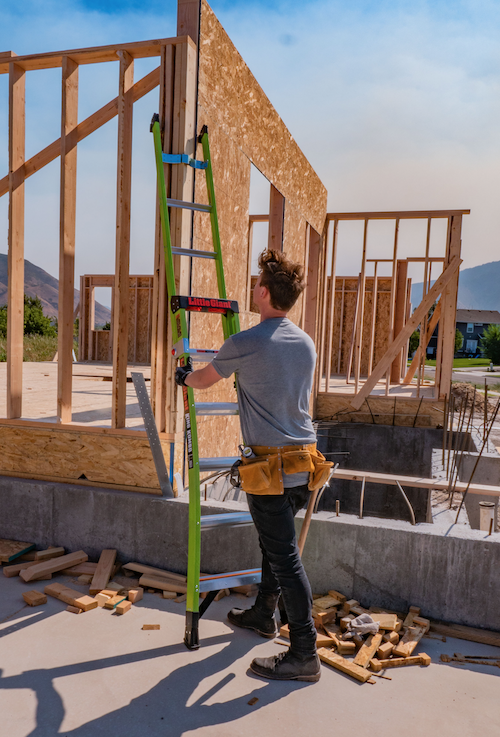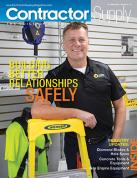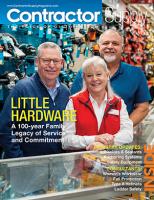Exclusive: Quick ladder safety tips for suppliers to remember
Little Giant reminds distributors to share ladder safety awareness with customers.

Chances are if you are on a ladder, you’re up there to get something done, and the goal is to get it done quickly and safely.
Falls are a leading cause of accident and injury and ladders are involved in many of these accidents. Every year, thousands of people are permanently disabled or killed in a ladder-related accident. Most of these tragedies can be avoided by following a few basic guidelines.
1. Choose the right ladder for the job (weight rating, material, length)
2. Inspect before use (If there is any damage, don’t use)
3. Set it up on firm level ground (Don’t use bricks or boards to level)
4. Keep your body between the siderails (Don’t overreach)
Ladders have been around for a long time, but over the last hundred years the design has not changed very much. Understanding how people use ladders, and more importantly, how they get injured using ladders, is key to designing new, safer climbing products. Studying the statistics, we can divide ladder accidents into three categories:
- Strains and sprains from unloading, carrying and setting up the ladder. Almost half of the reported injuries involving ladders are caused by the awkward size and weight of the ladder. The easy solution to this problem is to make it lighter.
- Using the wrong type or size of ladder for the job. A lot of times this is caused by the first problem. The right size ladder is too heavy, so we grab the smaller one and try to make it work by climbing to high on the ladder.
- Falls from height due to overreaching or improper setup. All three are painful and costly but a higher percentage of disabilities and fatalities come from catastrophic falls from height, so let’s spend some time on this one.
Overreaching
"I was just trying to reach that last thing" is the start to a lot of terrible ladder accident stories. We are trained to keep our bodies between the side rails to prevent us from overreaching. However, we know this doesn't always happen. Too often, we stretch to reach that one last thing instead of climbing down and moving the ladder. No matter how much we train people—it’s human nature. Understanding that this is a recurring problem we can design around it. Again, "Stop using Grandpa's ladder."
Uneven Ground
Another factor in side-tip accidents is how level the ground is in the set up. When working outside the ground is almost never level. It's not even level inside a lot of times. To give you an idea of how much level ground can affect tipping, if a 28-foot extension ladder is one inch off at the base, the top of the ladder will be 19 inches off, putting the top of the ladder completely outside the footprint of the ladder. Even if you are keeping your body between the side rails your ladder will tip.
When asked what they do when the ground is not level most people will say that they use a brick or a board to build up the low side of the ladder. Spending time on a scavenger hunt looking for the right sized board to level your ladder doesn't sound productive or safe. OSHA recommends you dig out the right side of the ladder instead of building up the low side, but workers rarely follow this rule because it is time consuming.
After-market leg levelers can be added to the base of your ladder, but they have two major problems. First, they add extra weight to an already heavy ladder; and second, they do not add extra stability to the ladder.
If you think about heavy aerial equipment on a job site, the manufacture adds outriggers to stabilize it.
Safety by Design
By adding outriggers to an extension ladder, we can increase the side-tip stability up to 600 percent. Because level ground is such a big factor in most side-tip accidents, designing the outriggers to also level will also greatly reduce the possibility of a tip due to overreaching. Extension ladders with outriggers are safer than straight ladders, an example of safer products by design.
Another design to help reduce tips on extension ladders is locking the top of the ladder in place with a self-locking attachment at the top of the ladder. These are three innovative tools that will increase stability on an extension ladder and reduce injuries, but what about a stepladder?
Stepladder Safety
Stepladders have different problems to overcome. People still tip over because of overreaching, but you also need to solve the three-points-of-contact issue and any tie-off rules that might apply. And you also need to work on uneven surfaces or staircases.
You should always maintain three points of contact when ascending and descending a ladder (two feet, one hand or two hands, one foot) but what do you do when you stop climbing and start working? Most safety people say you should still maintain three points of contact. Most workers will say it's hard to get the job done using just one hand.
The OSHA standard does not include portable ladders in the 6-foot tie off requirements for construction or 4-foot for general industry, but that has not stopped companies from including it in their best practices. These rules are meant to protect the user, but are difficult, even sometimes impossible, to follow.
By combining the platform and handrail system of an enclosed scaffold system with an adjustable fiberglass stepladder, you can solve all these issues. A caged platform allows workers to maintain three points of contact while working freely with both hands. The 42" handrail system on adjustable safety cages removes the need to tie off from above, allowing operators to get the job done quickly and safely, even when there is nothing to tie off to. The independently adjusting sides would also allow it to work safely on uneven ground and stairs.
Ladder accidents are preventable, but you need to follow the basic guidelines and stop using old technology. As a supplier, you can help your customers carry the newest, safest equipment to help prevent ladder-related accidents and injuries. CS
Source: Little Giant Ladders
Additional resources:














